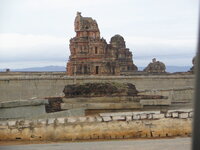Hampi
|
|
Template:World Heritage Sites in India
Hampi (Hampe in Kannada) is a village in northern Karnataka, India. Hampi marks the location of the ruins of Vijayanagara, the former capital of the Vijayanagara empire. Possibly predating the city of Vijayanagara, this village continues to be an important religious centre, housing the famed Virupaksha temple. The village of Hampi contains several monuments belonging to the old city, and extends into one of the old ceremonial streets. The Ruins at Hampi are now a UNESCO World Heritage Site. In recent years there have been concerns regarding damage to the site at Hampi from heavy vehicular traffic and the construction of road bridges in the vicinity. Hampi is now listed as a "threatened" World Heritage Site.
| Contents |
History
Hampi_by_sourabh_by_indians.jpg
Hampi is identified with the mythological Kishkindha, the monkey kingdom which finds mention in the Ramayana. The first historical settlements in Hampi date back to 1 CE.
The name "Hampi" is an anglicized version of the Kannada Hampe (derived from Pampa, the ancient name for the river Tungabhadra). Over the years, the city has also been referred to as Vijayanagara and Virupakshapura (from Virupaksha, the patron deity of the Vijayanagara rulers). Hampi is also called "The City of Ruins".
Hampi was the capital of the Vijayanagara empire from 1336 to 1565. The Vijayanagara rulers chose Hampi as their capital because of its strategic location, bounded by the torrential Tungabhadra river on one side and surrounded by granite cliffs on the other three sides. The establishment of suburbs like Tirumalapura, Krishnapura and Nagalapura turned the region into an agglomeration.
The downfall of the Vijayanagara rulers of Hampi came with the battle of Rakkasa-Tangadi (January 23, 1565), when the king Rama Raya was defeated by the combined forces of the Deccan Sultanates. Within a span of six months, the invading forces reduced the city to ruins. This region passed into the control of the Mughal rulers in 1689. In 1780, it became a part of the Nizam of Hyderabad's territories.
Geography
Hampi is situated on the banks of the Tungabhadra River, covering an area of roughly 26 km². It is 343 km from Bangalore, 254 km from Bijapur and 74 km away from Bellary. Hospet, 13 km away, is the nearest taluka headquarters. The chief languages spoken are Kannada, Telugu and English. The principal industries of the village are agriculture, the support of the Virupaksha temple and some other local holy places in the vicinity, and tourism. The annual Vijayanagar Festival is organized by the Government of Karnataka in December.
Temples
Hampi has various notable Hindu temples, some of them which are still active places of worship. Some of them are:
- Achyutaraya Temple
- Mahanavami Dibba (the royal observation platform)
- Hajara Rama Temple ("The Rama temple in the courtyard"): This temple has been carved with scenes from Ramayana. It is situated in an area within the palace compound, hence the name.
- Vitthala temple: The temple with 56 musical pillars is situated in a rectangular courtyard. It is especially famous for a stone sculpture of a chariot with revolving wheels, drawn by two elephants. The temple is the venue of the annual Purandaradasa festival.
- Virupaksha temple complex: Also known as the Pampapathi temple, it is a Shiva temple situated in the Hampi Bazaar. It predates the founding of the Vijayanagar empire. The temple has a 120 foot high tower at its entrance. Apart from Shiva, the temple complex also contains shrines of the Hindu goddesses Bhuvaneshwari and Pampa.
- Kodandarama temple: It is situated on the south bank of the of Tungabhadra river. It is identified with the place mentioned in the Ramayana, where Rama crowned Sugriva after defeating Vali.
Pictures
External Links
- Group of Monuments at Hampi - Unesco page (http://whc.unesco.org/sites/241.htm)
- Karnataka.com - hampi (http://www.karnataka.com/tourism/hampi/)
- A Guide to History and Tourism at Hampi (http://www.hampionline.com/)
- A traveller's note (http://www.agnescv.free-online.co.uk/india/html/hampi.html)
- Ruins - slide show (http://www.webonautics.com/hampi/)
- More photos and Information (http://travel.hubcom.net/sthindia/hampi.html)
- Hampi Pictures and Photos (http://amitkulkarni.info/pics/hampi/)
Books
- T S Satyan, Hampi: The fabled capital of the Vijayanagara Empire, (Directorate of Archaeology and Museums, Govt. of Karnataka, 1995) [ASIN B0006F9P9G]
- J M Fritz et al, New Light on Hampi: Recent Research at Vijayanagara, (Performing Arts Mumbai, 2001) [ISBN 818502653X]
- A N Longhurst, Hampi Ruins Described and Illustrated, (Laurier Books Ltd., 1998) [ISBN 8120601599]




